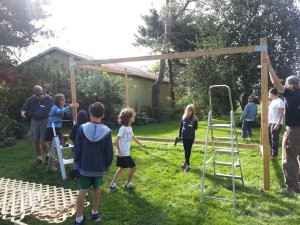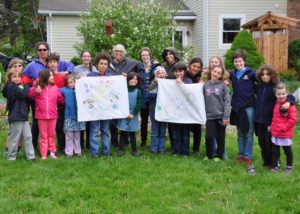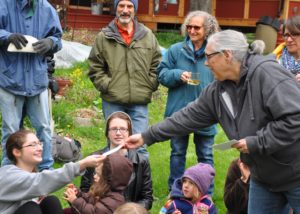Pictures telling the story of AARC Purim this year. Thank you Nancy Meadow, Fred Feinberg, Keith Kurz, and Emily Eisbruch for the photos.












Pictures telling the story of AARC Purim this year. Thank you Nancy Meadow, Fred Feinberg, Keith Kurz, and Emily Eisbruch for the photos.












The whole Beit Sefer showed their creativity in celebrating Tu B’Shevat this year.










This coming Sunday morning, Oct 16, 2016 9:30 to 11:30 during our regular Beit Sefer/Religious School time, AARC will be building a Sukkah at Carole Caplan’s farm, 6900 Jennings Rd. The students, teachers and parents will build the sukkah just like last year, and we welcome help from all AARC members and friends. We will scour the land for s’kach (raw, unfinished vegetable matter) roof cover; we’ll make decorations; we’ll sing some songs in the finished sukkah! Please give yourself enough time to arrive by 9:30 so we can get the sukkah built in time to enjoy it. The eight day holiday of Sukkot begins at sundown on Sunday Oct 16.
Our really delightful Children’s High Holiday machzor/prayerbook closed with the Ufros aleinu prayer which is part of the evening Hashkivenu prayer. The prayer asks God to spread over us a sukkat shalom/shelter of peace. As Rabbi Rachel Barenblatt says,
“During evening prayer there’s an extra blessing added — extra because it doesn’t appear in morning or afternoon prayer — which asks God to shelter us through the coming night. We pray ופרוש עלינו סכת שלומך, ufros aleinu sukkat shlomecha, ‘spread over us the sukkah of Your peace.’” Here’s a link to her blogpost “Shelter and Peace.”
And here’s link to the Hashkivenu prayer as sung during St. Louis’ Central Reform Congregation’s evening service. Recording features a wonderful group of CRC musicians: Rabbi Randy Fleisher, Leslie Caplan, Marty Miller, Andrew John, and Steve Friedman.
When we build a physical sukkah together, we can bring the meaning of this even closer. Enjoy, and see you Sunday.
by Clare Kinberg, Beit Sefer director
Last year, on the first day of our religious school, Beit Sefer, I told a story about the word Hebrew word “tebah”תֵּבַ֣ת. When we meet again for the first session this year (10am Island Park) I want to tell the same story. I’m pretty sure at least some of the kids will remember it if I tell it again. I hope so, but it doesn’t matter.

It is Jewish tradition to tell the same stories over and over again. And every time a story is told, even with the same words, it is a different story, because the hearer has changed. You are not the same person you were last time you heard the story. As adults, we’ve heard many stories in the Torah dozens of times. Yet, what you hear and understand from a story, using the exact same words, is different every time you hear it.
Here is the story at I told it last year:
The stories that Jews tell from the Torah are some of our oldest stories. In fact, something like 200 generations of Jews have passed down the stories that are in the Torah. One of the oldest ones, and a story that is told by lots of different peoples, is the story of a great flood that covered the earth, and one family–Noah, his wife Nehama and their children–and the ark they built to ride on the waters of the flood and to save the plants and animals so that the earth could start over.
In Hebrew the word for Noah and Nehama’s boat is tebah. A tebah is a special boat that keeps its passengers safe. In the whole Torah there is only one other tebah: while Noah and Nehama’s tebah was large enough to hold a pair of every animal and every plant on earth, the other tebah was so small it held only one baby passenger. In the Torah stories, about 100 generations after the great flood, the baby Moses was born and his sister, the prophet Miriam, built a small tebah, a basket more like a cradle than a huge ark, to save Moses’ life. When Moses was a grown man, so the story goes, he led the Jews out of slavery. So while one tebah played a part in saving life on earth, the small tevah played a part in saving the Jewish people.
Since one word, tebah, is used to mean such different things, a colossal ship made of gopher wood and a baby basket made of reeds, perhaps the meaning of tebah, is “life-saver.”
Or maybe it is the stories themselves that are the ark, the boat, that keeps us afloat. The stories I mean are both the stories that have been passed down generation to generation, and the stories we are creating with our own lives.

Last year, on the opening day of Beit Sefer, we passed a small boat shaped basket around a big circle of parents and students. As we passed the basket, we each recited, “This basket holds our stories, pass it on.” Then, the person accepting the basket replied, “Thank you, I will learn the stories and pass them on.”
This year on opening day, we are going to make the baskets, and we are going to make a new story, all together. Beit Sefer begins at Island Park at 10am. Parents are asked to stay for a meeting, and to play a special role in writing a story and helping the students launch a tevah on the Huron River. Immediately following the launch, will be our AARC Annual Picnic. Noon to 3pm. Bring protein to grill, a side dish to share. AARC will provide drinks and paper goods.
See you there!
 by Clare Kinberg
by Clare KinbergAs Beit Sefer/Religious School director, and with our summer recruitment drive swinging into gear, I’ve been asking myself: What do parents look for when choosing a Jewish religious school? The decision to send a child to religious school is a big one for parents: it sends a strong message to your child that “Jewish identity is very important to me, and I want it to be important to you.” Some parents look to repeat their own experience; others are emphatically looking to not repeat their Hebrew school experience; still others are looking for the Jewish education they never had. Parents usually want their kids’ Jewish educational experience to be in a community that reflects them and their values.
And then there are also all the practical matters: Does it fit our family’s schedule? Is it affordable? Experts in the field and my own experience agree that parents have these and many other questions: Who will be teaching my children? How will Hebrew be taught? Will we be expected to attend services with the congregation? Parents are anxious about their children fitting in and about the friendliness of other parents.
So, what can I do to help families decide if our school is right for them? I want to meet individually with each family that might consider enrolling their children in the school and to talk about things like: What are your hopes for your children’s Jewish education? Do you want to be involved by volunteering in the classroom, sometimes learning alongside your kids, participating in holiday celebrations together? Are there particulars of your own family’s beliefs and backgrounds that you want respected?
I want parents to know that the Beit Sefer teachers and I really celebrate the diversity of experiences of each student and their family and that we will be authentic about our own Jewish practice. I want them to know that we intend for their children to learn Jewish traditions in prayer and practice so that they are prepared to create Jewish practice that is personally meaningful. With that goal in mind, our curriculum includes instruction on Jewish holidays, history, and values, with an emphasis on social justice. We also teach modern Hebrew and the decoding skills that will prepare children to engage with liturgical texts.
A current Beit Sefer parent says:
As someone who got his fair share of Jewish education (little of it very rewarding, let alone enjoyable, and some of it literally scary), I really like that the Beit Sefer and AARC have led my son to developing an enthusiastic, proud Jewish identity that’s not tribal or elitist. I think the real sign that we’re on the right track is that my kids are excited to go to Beit Sefer and AARC events, and were bummed when Beit Sefer wrapped up for the summer.
Most of all, I want families to know that our religious school provides a warm, nurturing, welcoming environment for children and for parents. A central goal of the AARC Beit Sefer is to build and sustain community. While the time commitment for AARC Beit Sefer is minimal–one Sunday morning each week during the school year–students and their families are warmly invited to participate in and help to create Shabbat and holiday observances with the AARC community. All children are welcome to attend the Beit Sefer, and to participate with their families in AARC observances, regardless of their family’s formal religious affiliation or membership in the congregation.
From another parent, new to our religious school this year:
We were looking for a place where our son could learn about Jewish history, culture, and language, while being taught enough about the underlying beliefs to allow him to make an informed spiritual decision when he is older. The AARC Beit Sefer was welcoming to our interfaith household, and provided just the sort of nurturing-yet-fun learning environment we were looking for, and our son loves attending.
The AARC Beit Sefer teachers and I are very proud of what we accomplished in our Hebrew school last year. I am excited to share this experience and our plans for next year by meeting personally this summer with prospective families.

The last day of AARC Beit Sefer/Religious School was spent out at Carole Caplan’s land just outside Ann Arbor. May 15 was a chilly, beautiful day, captured by parents Nancy Meadow and Karin Ahbel-Rappe.









 This year, I helped Morah Sharon Alvandi with the Beit Sefer G’dolim class. The class had eight kids, ages 10-12. We did a lot of things over the year: learning about Jewish communal responsibilities and communities around the world, improving Hebrew skills, and mastering the core Shabbat morning prayers.
This year, I helped Morah Sharon Alvandi with the Beit Sefer G’dolim class. The class had eight kids, ages 10-12. We did a lot of things over the year: learning about Jewish communal responsibilities and communities around the world, improving Hebrew skills, and mastering the core Shabbat morning prayers.
The kids worked really hard to learn about the Shabbat service’s structure and prayers, and yesterday, they led the central part of the AARC’s Second Saturday service. The afternoon before, we gathered to bake for the kiddush that followed the service. We made brownies and cupcakes, and I showed the kids how to bake challah.
Here’s the recipe:
Ingredients:
- 4 (.25 ounce) packages quick-rise yeast
- 4 cups warm water (110 degrees F/45 degrees C)
- 2 tablespoons salt
- 3/4 cup white sugar
- 1 cup pareve margarine (but I use butter instead), melted
- 5 eggs
- 12 cups bread flour, or as needed
- 1/2 teaspoon vanilla extract
- 1/4 cup sesame seeds (but I don’t use these)
Prep time: 40 minutes / Cook time: 30 minutes / Ready in 2 hours, 40 minutes
- NOTE: I usually only make half of this recipe. It makes 4 loaves. if you make half, you can still make 2 loaves.

What is the tradition all about of Jews going on outings to fields or parks on Lag B’Omer, the 33rd day following the first night of Passover? This year the 33rd day of counting the Omer won’t be till May 26th… but in traditional AARC practice, we’ll celebrate at a conveniently-close-enough time (May 15th, 9:30-11:30am)!
Lag B’Omer is a day of rejoicing in nature, especially for children; a day of appreciating the budding trees and the blooming flowers. For Torah background on Lag B’Omer, “Judaism 101” has a good entry:
According to the Torah (Lev. 23:15), we are obligated to count the days from Passover to Shavu’ot. This period is known as the Counting of the Omer. An omer is a unit of measure. On the second day of Passover, in the days of the Temple, an omer of barley was cut down and brought to the Temple as an offering. This grain offering was referred to as the Omer.
For a good overview of contemporary practices, Big Tent Judaism uses a very nice entry taken from Sacred Celebrations: A Jewish Holiday Handbook, by Ronald H. Isaacs and Kerry M. Olitzky.
Many synagogues hold picnics and outings on Lag B’Omer, with food, music, dance, sporting events (often in the form of the competitive Maccabiah), and other festivals. It is often the last social get-together before the summer vacation. Jewish weddings are often held on Lag B’Omer as well. Some synagogues hold a bonfire and cookout on Lag B’Omer which often includes Israeli singing and dancing.
In Israel, Lag B’Omer is a day for bonfire celebrations. The most famous is held at the village of Meron, near the northern city of Safed. Shimon Bar Yochai is said to be buried there, and huge crowds gather at his tomb for this very happy celebration. It is said that while Rabbi Shimon Bar Yochai was hiding in his cave he wrote a famous holy book of mysticism called the Zohar. On Lag B’Omer, many of the Hasidim study portions of the Zohar during the special celebrations at Meron.
Finally, some synagogue schools have turned Lag B’Omer into a day for honoring their religious school teachers. Special assemblies and parties are held, and awards are often given to the teachers.
AARC Beit Sefer will try out several of these practices on Sunday May 15th, 9:30-11:30, when we meet at Carole Caplan’s farm for a special last session of the year. Other members and friends of the congregation are welcome to bring a dish and join the Beit Sefer families in the fun. Contact Beit Sefer Director Clare Kinberg for info, ckinberg@gmail.com.
AARC Beit Sefer has had a terrific year–with fun and engaging teachers and madrichim/teenage teaching assistants, lots of parent participation, and integration into the whole congregation. Member Becky Ball, mom to Sam and Joey, has stepped up to chair the Beit Sefer committee which includes Sarah Abramowicz, Candace Bramson, Stacy Dieve, and Allison Stupka (and Clare Kinberg, ex officio in her role as Beit Sefer director).
We’re all working to showcase and grow the Beit Sefer–and that includes an Open House this Sunday (May 1) for prospective students and their parents. It’s during the normal school time–9:30 to 11:30 am. Here’s the article in the Washtenaw Jewish News (page 8) about the Open House (thanks for writing it, Becky!). Do you know someone who might be looking for Jewish education for their elementary age kids? Please invite them! You can use this letter as a template. And don’t forget to join us at second Saturday services on May 14, 10 am, led by the G’dolim.
WJN-May-16-web-BeitSeferOpenHouse
 AARC Beit Sefer teacher Sharon Alvandi is a student in the UMich Jewish Communal Leadership Program, and an intern at Jewish Family Service learning to work with refugee families. Sharon has been very inspired by our AARC congregation, particularly the ways that the Beit Sefer students, parents and other community members come together to share learning and activities, investing in the character of the children. Through her work with JFS, Sharon is organizing a way for us to practice the mitzvot of Purim, giving gifts of tasty treats to one another/mishloach manot, and gifts to the poor/mattanot le-evyonim (for more about how these two mitzvot are related see this). Sharon writes:
AARC Beit Sefer teacher Sharon Alvandi is a student in the UMich Jewish Communal Leadership Program, and an intern at Jewish Family Service learning to work with refugee families. Sharon has been very inspired by our AARC congregation, particularly the ways that the Beit Sefer students, parents and other community members come together to share learning and activities, investing in the character of the children. Through her work with JFS, Sharon is organizing a way for us to practice the mitzvot of Purim, giving gifts of tasty treats to one another/mishloach manot, and gifts to the poor/mattanot le-evyonim (for more about how these two mitzvot are related see this). Sharon writes:
There are many reasons to celebrate Purim and sort through a narrative that’s truly unlike any other in Jewish scripture. On Purim- the holiday of “lots”- we celebrate more than simply the idea of chance. When we listen to Esther’s story, we collectively celebrate character, resolve, and integrity. By presenting her true self–her Jewish self–to king Ahasuerus to appeal for the fate of the Jewish people of Shushan (present day Susa, Iran), Esther is a model of advocacy for herself and others. As a developing social worker, this story helps me think about what it takes to act in a way that integrates all parts of who I am.
Purim also commemorates what it means to survive genocide or the threat of genocide. Each day when I work at JFS, I have the opportunity to observe the strength of character of the clients and the meticulous work of the case managers to serve a community of refugees in making the best choices in their first days in the U.S.
JFS has resettled over 350 refugees since 2009. Countries range from Iraq, Afghanistan, Somalia, Ethiopia, Iran, Syria, and Burma. JFS is set to resettle 150 individuals by October 1, 2016. AARC can help with the resettlement of families by joining with JFS to assemble and donate Welcome Baskets for refugee families in Washtenaw County. We can do more than discuss violence that is taking place abroad. We can welcome those in our community who have found refuge in a new place. This Purim, we can help make a space of comfort for their true selves.
Sharon has put together a list of personal care and household items the new families need upon arrival to set up their new homes. Check with this registry to see what is needed. We ask that you buy these items new and when you have, check off the registry. We will assemble the Welcome Baskets some time during the Purim Shabbaton March 25-27.
